Robotic surgery (also called robotic-assisted surgery) is perhaps the most cutting-edge medical technology of modern times.
The most widely used system today involves a camera and the use of very small surgical tools attached to robotic arms. A specially trained surgeon controls the robotic arms from a viewing screen, which is usually situated in the same room as the operating table. But the viewing screen could be located far away, allowing surgeons to perform telesurgery from remote locations. The screen is part of what is referred to as a console, which allows surgical procedures to be performed from a seated position, while the surgeon views a magnified three-dimensional view of the patient’s surgical site.1
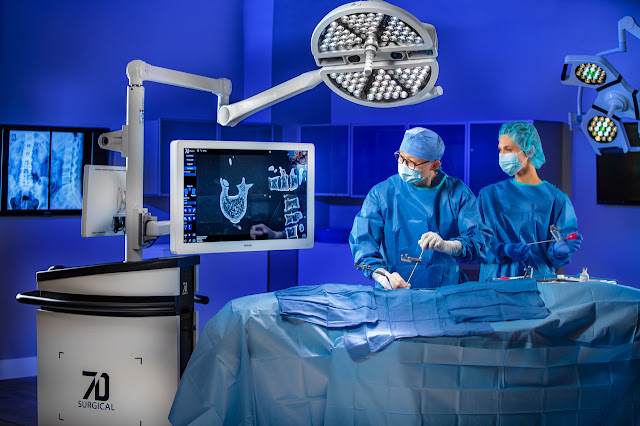
Contrary to what many people believe about robotic surgery, it’s not actually performed by robots. Rather, the surgeon is continuously in complete control of the robotic arms. The robot serves as a tool and could be seen as an assistant of sorts to the surgeon, thus, the name, robotic-assisted surgery.
The History of Robotic Surgery
Robotic surgery has been around for many years, in fact, according to a 2014 report by the American Journal of Robotic Surgery, the first robot was used to perform a brain biopsy procedure in 1985.2 This first innovative robot was called the PUMA 200 and it was made by Westinghouse Electric.
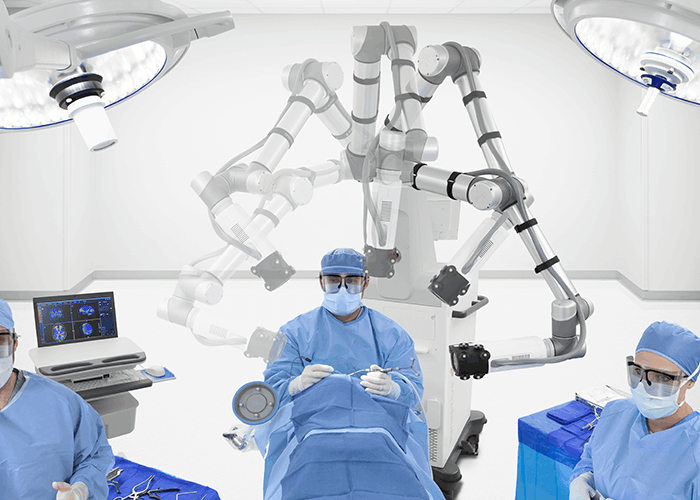
The PUMA 200 model has long been outdated, particularly with the launch of the robot model that is commonly used today, which is called the da Vinci robot. The da Vinci model was introduced in the year 2000. The early de Vinci model was the first to be approved for general laparoscopic surgery (minimally invasive surgery of the abdomen or pelvis with the use of a camera). Since that time, the field of robotic-assisted surgery has exploded due to the drastic improvement in technology.
Today’s robotic surgery technology has improved dramatically in its accuracy, imaging technology, range of motion, and more. The modern robotic technology has also been adapted for multiple surgical specialties such as neurosurgery (the brain, spinal column, and peripheral nerves), heart and lung procedures, ear and throat surgeries, and more.
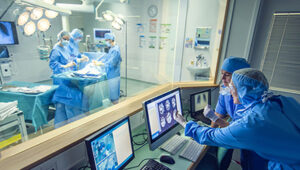
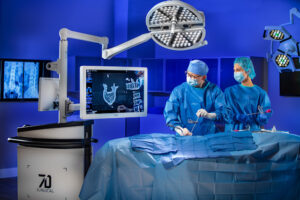
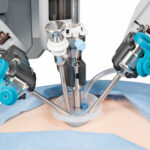


What Is Minimally Invasive Surgery?
Robotic-assisted surgery is performed using a minimally invasive surgery technique. What this means is that instead of making a large incision to expose the surgical site and perform surgical procedures, the robotic arms access very small incisions, (usually around 1 to 2 centimeters) to insert very small tools, guided by the surgeon.
Non-robotic minimally invasive surgery (also called endoscopic or laparoscopic surgery) can be done utilizing an endoscope (a narrow tube with a camera that is inserted through small incisions or through a natural opening such as the mouth or nose). But in non-robotic endoscopic surgery, the surgeon directly controls the small instruments via a channel (instead of controlling the robotic arms) while viewing the surgical site on a computer monitor.3
One primary difference between traditional laparoscopic surgery and robotic-assisted surgery is the degree to which the tools can be manipulated. This is due to the higher level of range of motion and increase in the dexterity of movement that can be attained using robotic technology.
Who Should Not Have Robotic Surgery?
There are several reasons that robotic-assisted surgery is not an option, these may include:
- Obesity. Certain types of fat may interfere with a surgeon’s ability to perform the procedure optimally. However, not all people who are obese will automatically be disqualified from robotic-assisted surgery; it depends on a person’s specific anatomy, the type of procedure, and other factors.
- Specific conditions or types of surgery. Many conditions cannot be performed via robotic-assisted surgery. One example is plastic and reconstructive microsurgery. The specific technology required to perform plastic and reconstructive microsurgery procedures has not yet been launched. Today, the majority of the instruments used in robotic surgery are much too large and have not been designed to perform microsurgery on the delicate tissue involved in many reconstructive procedures. Also, the magnification of the surgeon’s view using the robotic assist technology is not magnified enough for sufficient viewing.4
- A specific risk or contraindication. These are situations that would result in a high risk of harm. For example, robotic surgery should not be performed in a critically ill patient who needs emergency surgery or a trauma patient.
- Some types of comorbidity. Comorbidity is having more than one medical condition at a time. Patient who have had a recent heart attack or adhesions in the abdominal cavity are not good candidates for robotic surgery.
If you are uncertain about qualifying for robotic surgery, be sure to have a discussion with your healthcare provider. Many times the hospital has a special board that makes decisions on who qualifies for robotic-assisted surgery, so there could be a period of time that you have to wait for the professionals to decide on your specific case.
Benefits of Robotic Surgery
There are several major benefits of receiving robotic-assisted surgery, these include:
- Improved dexterity of the robotic devices (compared to a surgeon’s hand) which allows for access to hard to reach places
- Better visualization of the surgical site due to the magnification of the camera which is displayed on the surgeon’s viewing screen
- Less fatigue for the surgeon
- Elimination of surgeons’ hand tremor (a common phenomenon, particularly during long surgical procedures)
- Shorter hospital stays and faster recovery for the patient (due to smaller incisions and other factors)
- Less risk of infection (compared with traditional surgery).
- Less blood loss and fewer blood transfusions required (compared to traditional surgery)
- Less pain and scarring
- Less time after surgery for the patient to return to normal activity
- Quicker return to normal function (for example, a prostatectomy performed via robotic-assisted surgery is known to dramatically reduce the time that a person is unable to urinate normally and promotes quicker return of normal sexual function after surgery).5
Risks of Robotic Surgery
Although robotic-assisted surgery is generally considered safe, there are some factors that may increase the risk of injury during surgery, these include:
- Potential for human error in operating the technology. This risk is higher when a surgeon is less experienced, and when a surgeon is not considered to have mastered the learning curve in performing robotic surgeries. The number depends on the type of surgery. Studies have shown that mastery of the robotic learning curve can be anywhere from 20 procedures (for gynecologic procedures, such as tubal ligations) to 250 procedures for robotic-assisted laparoscopic prostatectomy RALF (removal of the prostate gland and tissues surrounding it).6
- Mechanical failure. Although mechanical failure is rare during robotic-assisted surgery, there are many mechanical components that could potentially fail, including the robotic arms, instruments, camera, and more.6
- Electrical arcing. This could cause unintentional burn injuries from the cauterizing device.7 Arcing happens when the electrical current from robotic instruments leave the robotic arm and are misdirected to surrounding tissue. The newest robots have safety devices that provide a clear warning to surgeons when instruments, have the potential to arc.
- Nerve damage. This can occur due to the position a patient must maintain during some procedures, or from compression from the robotic arms (this reportedly poses a very small risk).6
Risks that apply to any type of surgery, including robotic-assisted surgery include:
- Risks of anesthesia, such as pneumonia (these include any type of surgery)
- Allergic reactions to medications
- Breathing problems
- Bleeding
- Infection
Studies on Robotic-Assisted Surgery Risks
A 14-year study, published in 2016, discovered that the highest probability of adverse events resulting from robotic-assisted surgical procedures was seen in complex surgical specialties of cardiothoracic (heart and chest) surgery as well as in head and neck surgery.7 The study authors wrote, “Device and instrument malfunctions have affected thousands of patients and surgical teams by causing complications and prolonged procedure times.”
Another study, published in 2019, reported that the majority of serious events from robotic surgery involved lacerations, bleeding, complications from patient positioning, retained foreign bodies, and infections.8
Note, keep in mind that all types of surgical procedures pose risks, including traditional surgery as well as other types of minimally invasive surgery (such as laparoscopic surgery and open surgery). To properly weigh the risks versus the benefits of robotic-assisted surgery, it’s important to consult with your surgeon and other healthcare providers when considering robotic-assisted surgery.
Conditions Commonly Treated With Robotic Surgery
There are many different types of surgery that can be performed using the robotic-assisted technology, including:
- General surgery such as gallbladder removal, severe gastroesophageal reflux disease GERD, gastric bypass surgery and gastric banding, pancreatic surgery, liver tumors, and more
- Head and neck surgery such as tumors of the throat or tongue, thyroid cancer, and more
- Colorectal surgery such as surgery for colon cancer, treatment for Crohn’s disease, and more
- Urological surgery such as prostatectomy, kidney stones or other kidney disorders, urinary incontinence, kidney or bladder surgery, and total or partial kidney removal
- Gynecologic surgery such as tubal ligation (a surgical procedure to prevent pregnancy), ovarian or cervical cancer, ovarian cysts, uterine fibroids (benign growths in the uterus), hysterectomy (removal of the uterus and ovaries and parts of the vagina and cervix), and more
- Thoracic (chest) surgery for conditions affecting the lungs, such as lung tumors, or esophagus (esophageal cancer)
- Heart surgery such as coronary artery bypass, mitral valve prolapse, atrial fibrillation (irregular heart rhythm) and more
- Cancer surgery to remove tumors, particularly those near vital body parts such as blood vessels and nerves
- Orthopedic surgery such as a total hip replacement
Before Robotic Surgery
Before surgery, it’s important to:
- Gather information about the procedure
- Discuss the risk and benefits of robotic-assisted surgery with your surgeon
- Follow your surgeon’s pre-operative instructions regarding what medications to eat, and what to eat and drink before surgery (usually foods and fluids are to be avoided for at least eight hours before surgery).9
- Some procedures (such as colon procedures) require that you use an enema or laxatives to cleanse the bowel before surgery.
- Remember to mention any over-the-counter medications as well as natural herbs or supplements you are taking, in addition to prescription medications, and follow the healthcare provider’s instructions on what to take and when.
- Be aware that any type of medication that could result in decreased clotting time may cause bleeding during the surgery, such as aspirin, Coumadin, or Plavix; these medications should be withheld for 10 days before the surgery.9
- Arrange for help to drive you home after the procedure and help with daily activities until you are fully recovered.
During Robotic Surgery
The steps for receiving robotic assisted surgery include:
- You will be given general anesthesia to induce sleep and eliminate any sensation to pain.
- Small incisions (approximately 1 to 2 centimeters or 0.393 to 0.787 inches in length) are made by the surgeon to allow for placement of the instruments into the body (note, this is the reason robotic surgery is usually referred to as minimally invasive surgery).
- A small, flexible tube with a lighted camera (called an endoscope) is used to allow the surgeon to have an enlarged 3D view of the surgical site. Your surgeon inserts miniature robotic instruments and the powerful camera into your body.
- Your surgeon then sits at a nearby console (a large computer) to direct the procedure. At the console, the area of operation can be seen highly magnified, with excellent resolution.
- Sitting at the console, your surgeon manipulates the de Vinci’s robotic arms (attached to the surgical instruments) with the use of hand and foot controls; another surgeon serves as an assistant who is positioned at the operating table to confirm the placement of the surgical instruments. The instruments respond to these movements and translate them into precise, real-time movements inside your body. The robotic devices, which have greater dexterity and range of motion than a human, allow your surgeon to successfully perform delicate surgeries in hard-to-reach places.
- Organs that need to be removed (such as a gallbladder) will be removed through one of the small incisions.
- After the procedure is complete, the incisions are closed and covered with a small dressing.
After Robotic-Assisted Surgery
Although recovery after robotic surgery is usually much shorter and less painful than traditional surgery, there may be some activity and lifting restrictions, post-operative (after surgery) instructions may include:
- You may be instructed by your surgeon to abstain from heavy lifting or straining until your healthcare provider approves resuming normal activities.
- Your surgeon may advise you to abstain from driving for at least one week.
Follow your surgeon’s instructions on pain medication or other post-operative instructions after surgery. - Instructions to contact your healthcare provider if your pain worsens (particularly if it is not relieved by pain medication) you experience nausea and vomiting, bleeding,
- Instructions to contact your healthcare provider if you have redness or pus at one of the surgical sites (this may indicate an infection has started.
- ROBIN is a collaborative Robot able to interact and support surgeons during bone resection tasks in TKA performed with a conventional cutting tool.
The precise and smooth ROBIN workflow will interact with the surgeon providing seamless valuable information for patient specific treatment, with real time check and target adjustment.
The OR staff empowered and adequately trained will be able to run TKA assisted by ROBIN without the need of any ROBIN technical specialist in OR.
ROBIN supports a pre-operative scanning free approach , providing savings of time and cost for the hospital.
-
PATIENTS
Improves clinical outcomes with safer intervention and faster recovery of expected quality of life targets, complication reduction and better post-operative satisfaction.
SURGEONS
Greater confidence operating with a precise and easy to use Collaborative Robitic – COBOT.
ROBIN is a smooth, interactive tool designed for top quality implants.
https://www.permedica.it/en/medical-professionals/robin/









 Total Users : 7338
Total Users : 7338 Total views : 14668
Total views : 14668